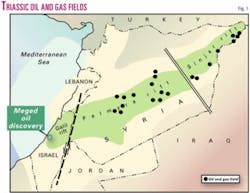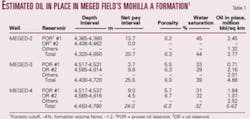Israel has what appears to be its first substantial onshore oil and gas discovery, but development may be difficult and slow of pace.
The third well drilled on the Rosh Ha'ayin structure 20 km northeast of Tel Aviv flowed light oil and gas from fractured Triassic Mohilla carbonate below 14,300 ft. Two previous wells were drilled on the structure in 1994 and 2000.
The operator, Givot Olam Oil Exploration LP, Jerusalem, estimates field size at 200 sq km. It judges one reservoir in the Mohilla A formation to contain close to 1 billion bbl of oil in place of which 200 million bbl are possibly recoverable. Israel's next largest onshore field, Heletz, has 18 million bbl recoverable.
The Israeli government granted the 247 sq km I/11 production lease in April 2004, effective for 30 years, covering Meged field on Givot Olam's 400 sq km L-244 license.
Outlook and timing of development of Meged field are uncertain. Reservoir consultants have advised that horizontal wells will be needed to establish commercial production rates.
Meged crude oil is 38° gravity with 0.2% sulfur, said Tovia Luskin, a geophysicist and company executive director.
Givot Olam is a public company listed on the Tel Aviv stock exchange. The company's main focus at present is finding a strategic partner.
In addition to sizable gas reserves in the Mediterranean, Israel produces at most a few hundred barrels per day, mostly from nearly depleted Heletz field.
OGJ estimated Israel's reserves at 3.8 million bbl of oil and 1.4 tcf of gas, and the Energy Information Administration estimated its oil demand at 279,000 b/d in 2003.
Discovery history
Givot Olam first drilled in 1994 in the Galil rift, a sliver of sediments lying east of the Levant basin and, as an offset extension of Syria's Palmyra rift, west of the Dead Sea fault between Jerusalem and Beirut.
Meged-2, first well on the structure, recovered a few gallons of dark brown oil, and log evaluation of the test zone indicated the presence of oil in the porous interval at 4,365-4,380 m. TD is 5,200 m.
The well encountered two independently sealed Triassic reservoir systems. The oil was identified as being from a source of Silurian age, but this sourcing is considered speculative in some geologic literature.
On retest in 1998, Meged-2 flowed at the initial rate of 400 b/d of oil and an estimated maximum flare of 1 MMcfd of gas.
Meged-3, 5 km northwest of Meged-2, went to TD 4,750 m in 2000 and confirmed the presence of the oil saturated Mohilla reservoirs but could not be tested due to mechanical problems in the main hole and a sidetrack.
Meged-4, 5 km northeast of Meged-3, went to TD 4,919 m and flowed oil and gas from Mohilla at unspecified rates.
Givot Olam also recognized other porous zones on the Meged structure in the Triassic and Permian formations that may contain oil and gas accumulations (Table 1).
The three wells established the existence of a gross oil column more than 300 m thick in the Mohilla. Mohilla is equivalent to the Mulussa formation in western Syria where, for example, wells in Marathon Oil Corp.'s Ash Shaer field flow at rates as high as 47 MMcfd of gas and 3,000 b/d of oil.
Production plans
Other than the risks of failure of 5-10% of development wells, extra risks may exist in Meged development, Givot Olam said.
Development likely will start with the horizontal completion of existing wells, Luskin said. It is unclear whether gas will be reinjected or sold locally.
Consultants said production profiles suggest that a single 1,000-m drain hole would have initial production of 900 b/d of oil and average 476 b/d the first year, declining to a stable 200 b/d during 7 years' production.
Two horizontal legs from the same vertical well will double these rates and drain about 5 sq km.
Givot Olam is considering a 50-sq-km development project starting as early as 2004 with 10 producing wells.
Potentially complicating development are reservoir quality variations, the presence or absence of fractures, and the chance that fractures might draw water from zones outside the producing area.
Mohilla description
The Mohilla A formation contains numerous layers of porous, oil saturated reservoirs, Givot Olam said.
"One such reservoir, 20 m thick, has been confirmed by all three wells as a regional continuous reservoir (Table 1, Proven Oil Reservoir No. 1).
"Based on the rock properties of the POR No. 1 it is calculated that each square kilometer of the oil structure contains approximately 2 million bbl of oil in place, making the Meged structure, size of 200 sq km, contain approximately 400 million bbl of oil in place of which 20-25% are recoverable," the company said.
"Another reservoir (OR No. 2) located deeper than POR No. 1 was not tested and contains an additional 1-2 million bbl of oil in place per square kilometer. Other potential oil reservoirs in the Mohilla A formation were not tested and contain an additional 1 million to 2.5 million bbl of oil in place per square kilometer."



